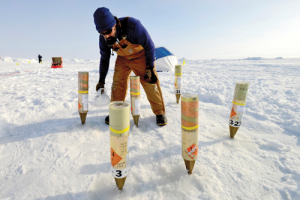Defence scientists test geobuoys in the Arctic
By Lookout on Jun 08, 2015 with Comments 0

DRDC technologist Tim Murphy pours water around hand planted icepick geobuoys at the DRDC ice camp north of CFS Alert.
For two weeks this spring a team of scientists, technologists and logistics support staff from Defence Research and Development Canada (DRDC) evaluated the performance of newly improved geobuoys on behalf of the Royal Canadian Air Force (RCAF).
“In order to conduct Arctic underwater surveillance in areas where the surface of the ocean is covered in ice, geobuoys play an important role in detecting and tracking underwater sounds,” said Major Glenwood Gullison, from the Directorate of Air Requirements in the RCAF.
Geobuoys contain vibration sensors that can detect sound that travels through the water and into the ice; they are one of the best ways to detect underwater sounds below the ice.
“Science and technology plays a pivotal role in the development of Department of National Defence capabilities,” said Maj Gullison. “The trial conducted by DRDC is part of this capability development and is an important contributor to maintaining airborne intelligence, surveillance and reconnaissance for the RCAF.”
Due to their specific expertise and extensive experience in underwater acoustics and geobuoy technology, DRDC are uniquely positioned to conduct the evaluation of the redesigned geobuoy, Maj Gullison added.
“DRDC is the only organization with the unique expertise to effectively test the product in operational conditions,” said Scott Campbell, an Undersea Sensor Systems Engineering Manager from the Department of National Defence.
This year’s trial is testing the effectiveness of the geobuoy’s modifications. The geobuoys were modified by updating the battery, weight, and centre of gravity. The goal is to validate the technical refresh in an operational environment.
Geobuoys are cylinder-shaped and contain a vibration sensor and radio transmitter, as well as a parachute on its tail and an icepick for a nose. They are dropped from an aircraft to conduct under ice acoustic surveillance.
In ideal circumstances, geobuoys fall pointing straight down and make a solid connection with the ice in order to effectively sense sounds travelling through the water and into the ice.
Additional geobuoys were also hand planted after the air drop, for specific tests. Ambient sound levels, ice motion and underwater noise were picked up by geobuoy sensors during tests.
“It’s important to test and improve geobuoy technology in order to keep devices reliable and relevant in their role of monitoring underwater sounds,” said the trial’s lead scientist Dr. Garry Heard of DRDC, a veteran researcher who has worked in the Arctic for several decades. “We need to know who is travelling in Canada’s Arctic.”
In accordance with the Canada First Defence Strategy, the CAF must ensure the constant monitoring of Canada’s maritime approaches, including the Arctic, in order to detect threats to Canadian security as early as possible.
“This includes underwater intelligence, surveillance and reconnaissance missions in the Arctic Ocean, conducted by the RCAF,” said Maj Gullison.
DRDC
Filed Under: Top Stories
About the Author:





